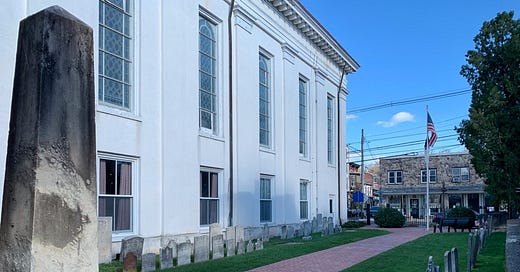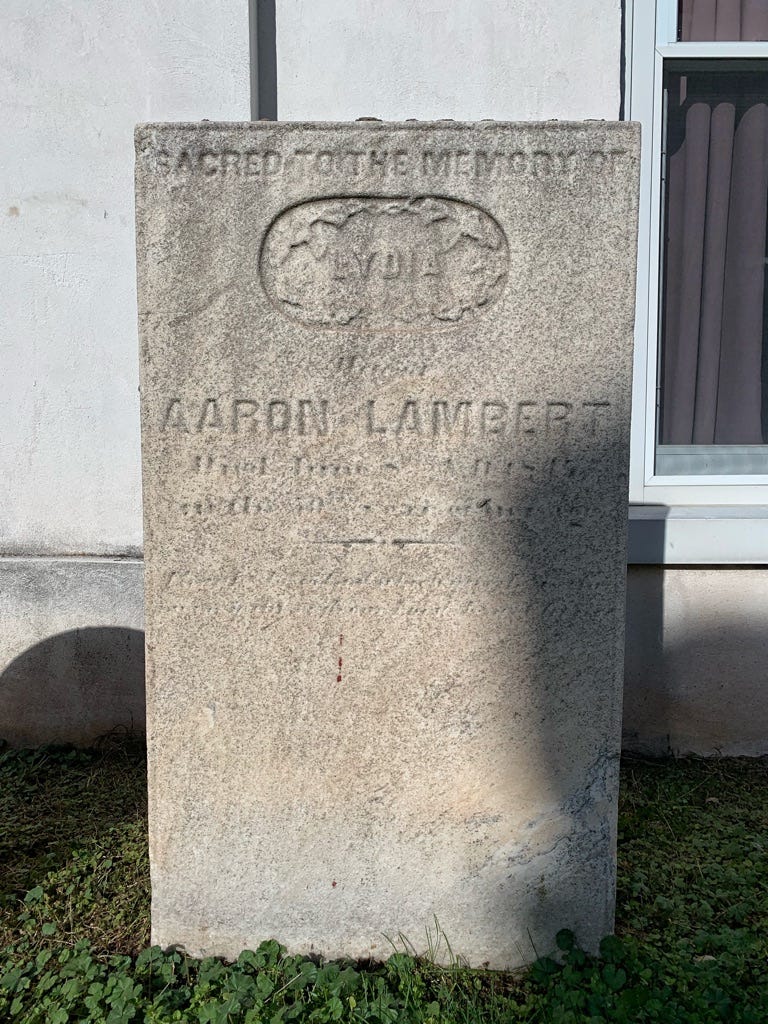Sunday Pastries With the Dead 8
The circa-1817 First Presbyterian Church Cemetery in Lambertville, NJ.
This tiny cemetery boasts just 79 graves, many of which appear to be stacked atop each other. Truly, I have no idea how the bodies are arranged beneath the closely-packed headstones. People couldn’t have been that much shorter in the 1800s. As I turn the possibilities over in my mind, the clink of silverware on plates and the low din of voices from customers at the next-door restaurant carry on the day’s cold wind.
When the cornerstone of this church was laid in 1817, the surrounding town had only 150 residents, 24 houses, and no mill or factory to speak of. Today, it has a population of over 4,000 and it’s a bustling shop and restaurant-packed destination for New York City day-trippers and locals alike.
In this area where New Jersey and Pennsylvania wink at each other from across the Delaware River, every old town has a heap of George Washington lore. He famously crossed the Delaware (you know the painting!) not far south from here, and his troops fanned out all over the region during the Revolutionary War. Anyone with a historical structure that dates back to his time will try to tell you that he sheltered in their barn or had a drink at their tavern. The stories are rarely verifiable, but it’s always fun to follow the threads of their yarns.
In this cemetery’s case, though, there are two bonafide connections to ol’ General, Founding Father, and first U.S. president George. First, we have George Coryell, who was not only one of Washington’s Revolutionary War Lieutenants, but he was also a pallbearer at Washington’s funeral. Also among the graves is Sam Holcombe, who was one of Washington’s spies during the war (I couldn’t find his exact marker—it’s likely one of the few that are weathered beyond recognition).
Joseph (left) had a total of 11 children with two wives—he’s also related to John Lambert, for whom this churchyard’s town is named (the surname is a pretty big hint). John (center) was related to the town’s first settler who came here in 1705. The town was originally called Coryell’s Ferry; Revolutionary War Private Abraham (right) is the son of the man for whom it was initially named. His brother Cornelius ferried and hid Washington’s troops along the Delaware just before the famous Crossing.
I have a lot to say about the “wife of” qualifier on most women’s graves from this time (headstones, like history, are written by men about—or in relation to—men). It’s a post for another day, but Lydia’s marker is an excellent example of the way women were relegated to the sidelines. Even her husband’s name is more prominent on her own gravestone. Sigh.
Rounding things out, we have the oldest headstone I could read (left)—and the only sandstone marker in the yard—in memory of dear six-month-old Matthew, who died in 1805. Also, a lovely alternate spelling of Phoebe (center), which I see often in older graveyards, and another of the more common Diana (right).
I think many of the interred folks who lived here back when it was just a small settlement are proud to be in the thick of things now, bearing witness to the ever-changing landscape of their beloved home. Between the restaurant next door, the bench at the far end of their yard, and the busy sidewalk beyond, they’re never in want of visitors or people-watching.










